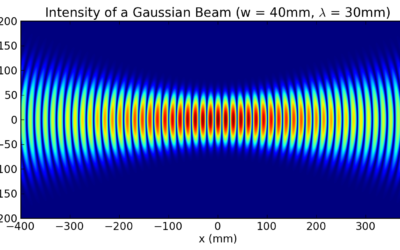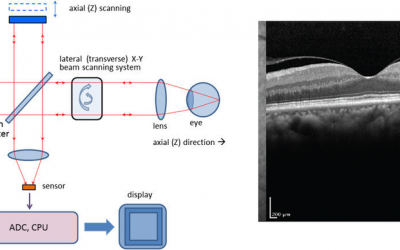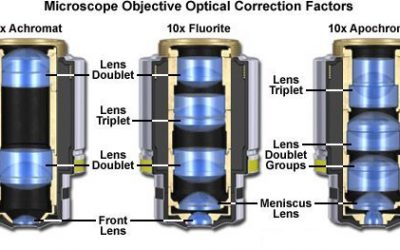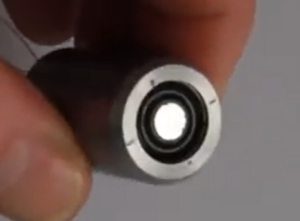One of the most common lens system designs- especially in photography- is what is called a Double Gaussian lens. There are several different configurations, and close to 90 different patents have been filed from 1936 – 2010. One of the reasons this lens design configuration is so popular is that it corrects many of the major image aberrations with a relatively low number of optical elements.
Blog
Laser Beam Caustic: Explained
by Victor Argueta | FAQ, illumination, optics definitions, Uncategorized
One parameter that can be used to evaluate the quality of a laser beam is what's called a Beam Caustic. A caustic, in general, is an “envelope” that defines the extent of a beam of light after they have been refracted (or reflected ) by a curved surface. As the...
Understanding Rayleigh Range: Key to Laser Beam Propagation
by Victor Argueta | FAQ, optics definitions
Introduction When working with lasers it is important to understand the physical parameters that define system performance. While some of these specifications may be readily recognizable, such as wavelength and divergence, others may be lesser-known, yet...
Laser and Adaptive Headlight Tech Explained
by Victor Argueta | FAQ, illumination, OFH, Victor Argueta
We explained the use and design of laser headlights and adaptive headlights in auto industry
3 Strategies for Field Lens Development and Design
by Victor Argueta | imaging, lens design, Uncategorized
Field lenses are a basic element in optical design, to understand their role in an optical system it’s important first to understand the definitions of Field-of-View (FOV). Generally speaking, FOV is the maximum size of an object that an optical system can create an...
Understanding the optics behind a PAPI light
by Victor Argueta | illumination, illumination lens design, LED, optical design
In a previous article we talked about Aviation Light Optics. and discussed a runway light system called Precision Approach Path Indicator (PAPI). Now we would like to go more in detail into PAPI design and describe their design requirements. The PAPI system...
Optics in the News – June 2022
by Victor Argueta | OFH, optics
Complex Optical Components from Fluids. Researchers from the Israel Institute of Technology have developed a new technique to fabricate free-form optics by curing a liquid polymer. Traditionally, free-form optics are fabricated using complex CNC equipment that...
Aviation Light Optic Design
by Victor Argueta | FAQ, illumination, Victor Argueta
In the last month, I have had the need to travel several times by airplane. So, after several hours enjoying $15 sodas, and $30 hamburgers at the airport gates, I started paying more attention to the different illumination systems that are being used in the aviation...
RXI Collimators explained
by Victor Argueta | FAQ, optical design, Victor Argueta
Optical collimators also called non-imaging concentrators are optical components that can collect and project light from a source. Common examples include solar collectors that concentrate the sun's light and project it to heat a surface or direct it to solar panels....
Non-Contact Tonometers
by Victor Argueta | FAQ, Opthalmology, optics, Victor Argueta
This will be the last entry in our series of optical instrumentation for optometry. If this is the first article that you are seeing, I would suggest that you take a look at our previous articles about Ophthalmoscope Design, Keratometer Design, and Retinoscopy. This...
Retinoscope Design
by Victor Argueta | lens design, Opthalmology, optical design, Victor Argueta
Retinoscopes are a very common optical instrument used by optometrists to examine a patient’s eye and evaluate the need of corrective lenses. They use a very interesting physical principle. Let’s first describe the optical instrument. The retinoscope is a hand held...
Keratometer Optical Design
by Victor Argueta | Opthalmology, optical design, Victor Argueta
In this article, we will continue our description of different optical instruments used by optometrists. Last time we talked about Ophthalmoscopes, today we will talk about another very common optical instrument called the Keratometer. The keratometer was developed...
Ophthalmoscope Optical Layout
by Victor Argueta | FAQ, Opthalmology, Victor Argueta
In the next couple of articles, we will talk about the different instrumentation used by ophthalmologists and optometrists. As you can imagine, there are many restrictions when designing an optical instrument that will be used in a patient. It matters whether the...
Scan Mirrors In Industrial Welding
by Victor Argueta | FAQ, Optical Components, Victor Argueta
This is our last entry on our scanning mirrors series. In this article, we will talk about the use of scanning mirrors when working with welding environments. As you can imagine, not only do the optical requirements differ when compared to those of a scanning...
Steering Mirrors In LIDAR Systems
by Victor Argueta | FAQ, lens design consulting, Optical Components, optical engineering, Victor Argueta
This is our third installment of a four-series blogs about steering mirrors. We have talked previously about steering mirrors in laser markings and steering mirrors in OCT systems. This week, we will talk about the steering mirror requirements for those in LIDAR...
Steering Mirrors in OCT
by Victor Argueta | Optical Components, opto-mechanical design, scanners
This week, we will continue our discussion of fast steering mirrors. If you missed our last article, go ahead and read about steering mirrors for laser marking. Here, we will discuss the design requirements for steering mirrors in Optical Coherence Tomography (OCT)....
Steering Mirrors in Laser Marking
by Victor Argueta | scanners
In the next couple of weeks, we will be talking about the different design requirements and restrictions when working with steering mirrors, also known as scanning mirrors. The objective is to show you that different applications require different solutions, and that...
Understanding objective lenses
by Victor Argueta | FAQ, lens design, Optical Components, optical design, optical engineering
Introduction In previous entries, we have talked about the design of scanning microscopes, infinity corrected microscopes, confocal microscope design, and Koehler illumination systems-a common illumination system in microscopes. The most essential microscope element...
Rigid Endoscope Design
by Victor Argueta | FAQ, optical design, optical engineering, Victor Argueta
Endoscopes are medical devices designed to collect the smallest images from inside the human body. Endoscopes can be divided into two categories: rigid endoscopes, in which relay lenses are stacked together generally creating a high-quality image, and flexible...
Cardinal Points
by Victor Argueta | FAQ, optical design, optics, Victor Argueta
When I was a young undergrad engineering student, I always found optics to be a very confusing subject. It was not only the equations, but what it looked like hundreds of different definitions involved in even the simplest of optical systems. Some concepts, like...





















